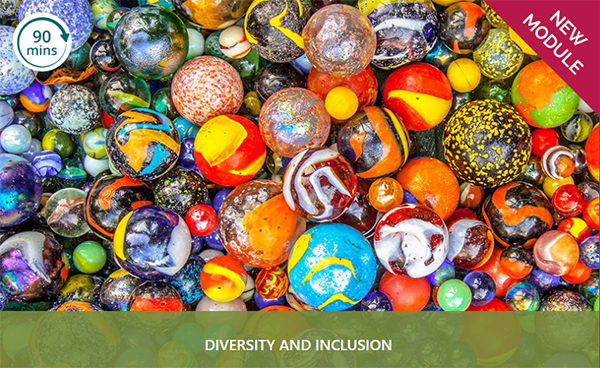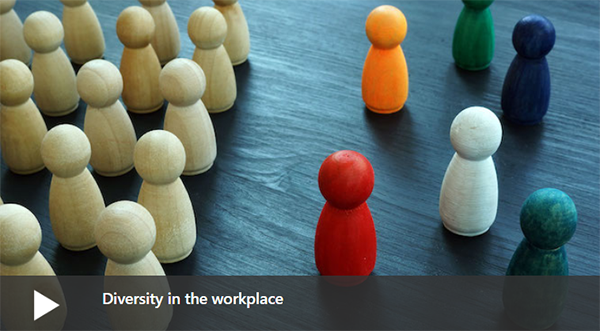Diversity has many definitions, according to our Professional Refresher module on the topic. "In general, it means understanding that each individual is unique and recognising our individual differences," it says. "These can be along the dimensions of race, ethnicity, sex, sexual orientation, socio-economic status, age, physical abilities, religious beliefs, political beliefs and other ideologies." This article will summarise some of the points made in the module.
The module outlines why diversity is important to a business, the main threats to, and challenges of creating, a diverse working environment, and why firms should have standards of conduct against discrimination.
Despite companies trying to improve their hiring and selection method, with some adopting 'blind audition' approaches – anonymous, skills-based assessments – many are still not fully maximising the benefit that diversity can offer, "such as getting the very best out of individuals and teams", it says.

Why it's important
A benefit of a diverse workforce, the module says, is that it can "differentiate firms from their competitors, help them reach a wider base of clients, and also attract the best applicants to fill vacancies".
The FCA has also spoken out on diversity in the financial services sector. In its 'Dear CEO' letter, published in January 2020, it reports its view on diversity and inclusion in terms of culture in the sector. "We view both lack of diversity and inclusion ... as obstacles to creating an environment in which it is safe to speak up, the best talent is retained, the best business choices are made, and the best risk decisions are taken," it says.
Having a diverse workforce can also benefit the wider society, the module says. "The concept of diversity encompasses acceptance and respect ... It develops an understanding of others over and above basic tolerance and embraces the various rich dimensions present in all of us. Cultural diversity can, and should, inspire creativity and drive innovation."
What's threatening diversity?
The module identifies stereotyping and bias as "some of the greatest threats to a diversified and healthy working environment". It says that "making employment decisions or treating people differently based on preconceptions or prejudices not only goes against firms’ anti-discrimination policies, but is also illegal".
Stereotyping, as the module defines it, is a "shared image of a group that is applied and generalised to members of that group as a whole, regardless of their individual qualities". Stereotyping a person can be inherent, acquired or practised, and can be an important source of prejudice and discrimination, the module says. Making employment decisions or treating people differently based on preconceptions or prejudices is illegal.
It goes on to explain how this can be present in the workplace. "When we meet a new colleague, a job candidate or a customer, we can immediately start paying disproportionate attention to their appearance, race, sex, age, body shape or disability, and make a judgement based purely on their 'looks'. We may also sometimes moderate and modulate our responses to a person based on any obvious or physical characteristics," it reports.
Bias also threatens diversity. There are different types of bias. Confirmation bias is defined in the module as "favouring certain, selective information to support pre-existing beliefs, theories or biases, combined with a tendency to interpret new evidence as confirmation of these". But unconscious bias is defined as "stereotypes about certain groups of people that individuals form outside their own conscious awareness". Unconscious bias is more prevalent than conscious bias or prejudice. How can we stop this?
According to a LinkedIn article by Gregory Lewis, published in July 2017, unconscious bias training doesn't work. Lewis writes: "Research shows that educating, training, and providing feedback to managers are the least effective ways to create a more diverse workforce. This poses a very real challenge when it comes to hiring for diversity. Raising awareness is a good first step, but it's not enough – you need real action. The most effective strategies focus on changing processes, not changing minds."
There are ways to mitigate certain biases in the recruitment process, the module says. These include:
- Similarity bias (which makes you think people similar to you are better than others) can be mitigated by re-programming your brain to categorise all people as your "in-group" and find commonalities with all candidates.
- Expedience bias (thinking our first impressions are true) can be mitigated by considering the information and the facts presented to you, making a pros and cons list and drawing up criteria that you apply to every candidate.
- Experience bias (thinking our subjective thoughts are objectively true) can be mitigated by having diverse opinions in the same room, forcing everyone to think more critically.
- Distance bias (thinking people closer to us are better than those further away) can be mitigated by applying and following a uniform process where possible. For example, this could mean interviewing all candidates via video conference so geographical location doesn't matter.
- Safety bias (thinking bad outcomes are more powerful than good outcomes) can be mitigated by trying to create a psychological distance from the situation. For example, you could imagine you are deciding for someone else: what advice would you give them? Putting yourself in someone else's shoes could help.

Discrimination and the Equality Act
The module also covers discrimination, harassment and victimisation. It outlines the protected characteristics in the Equality Act 2010, which prohibits discrimination and supersedes all related laws in the UK. These are the nine protected characteristics and the grounds upon which discrimination is unlawful, as presented in the module:
- Age – discrimination against a person's ability because of their age.
- Disability – discrimination on the grounds of any physical or mental impairment that does not have a substantial and long-term adverse effect on a person's ability to carry out the day-to-day activities of their job.
- Gender reassignment – discrimination against a person because they are transitioning from one gender to another.
- Marriage and civil partnership – discrimination against a person because they are married or in a civil partnership.
- Pregnancy and maternity – discrimination against a person during the period in which someone is pregnant and the period after the birth that is linked to maternity leave.
- Race – discrimination against a person because of their race, skin colour, nationality, or ethnic or national origins.
- Religion and faith – discrimination against a person because of their religious or philosophical beliefs or a lack thereof (ie, atheism).
- Sex – discrimination against a person because of their biological sex.
- Sexual orientation – discrimination against a person because of their sexual disposition.
The module also outlines the four main categories of discrimination (direct, indirect, harassment, and victimisation) and talks about the importance of firms having clear boundaries for what is unacceptable behaviour. It is also essential that firms have an anti-discrimination policy that sets out the standards of conduct in compliance with equality laws.
"Diversity is still having to play catch-up to become the 'new normal', but programmes put in place so far have resulted in fairer working environments and can be seen to be delivering positive results," the module says. However, it counters that with data from an update to the 2017 Parker review, launched to improve ethnic diversity on the boards of UK-listed businesses. According to the module, it reports that "almost 70% of the UK's top 250 listed companies have no ethnic representation on their boards".
Employers and employees need to keep pushing for diverse workplaces, continuously encourage diversity and inclusivity and continually monitor and review this. "Properly overseen and managed, diversity is a force for good in society – breaking down barriers so as to increase our understanding of each other's needs and desires so that everyone feels listened to, and that they have a voice and a valued contribution to make that benefits everyone," the module concludes.